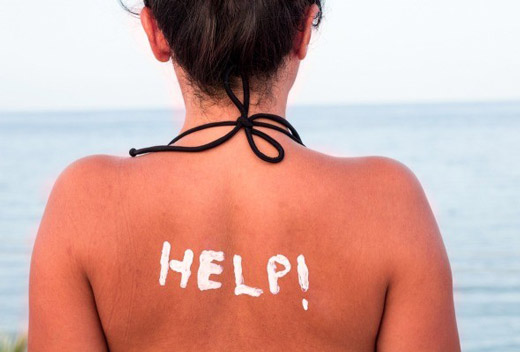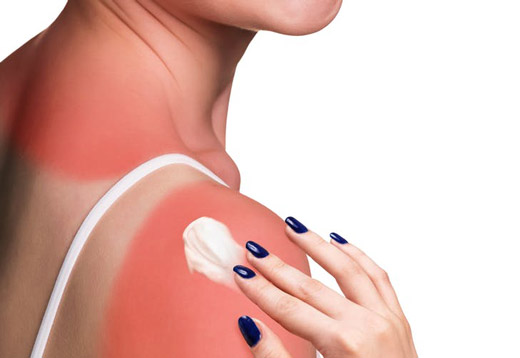Sunburn is an acute inflammation of the superficial layers of the skin that is a response to UV exposure. The main burn factor is the sun. As a result of prolonged exposure under it, edema, erythema, itching, burning sensation and pain are formed. Often a person does not even suspect that his skin is damaged. The first signs appear after 3-12 hours. The patient needs first aid and treatment.
Strong ultraviolet radiation can damage the surface of the skin and eyes. The severity of the injury can be mild to severe and cause serious consequences.
Areas of the body most susceptible to burns:
- forearms;
- face;
- back at the top;
- chest area;
- shoulder;
- leg.
The risk of injury depends on a large number of factors. Someone does not burn at all, but someone has to be wary of hot days. What is the reason?
Symptoms and severity depend on:
- places - the body and face have skin that is different in structure and susceptibility;
- type;
- individual sensitivity to ultraviolet light;
- the color of the skin (swarthy people tolerate the sun more easily);
- course treatment with drugs of a certain group;
- the presence of dermatological diseases and problems (moles, acne, etc.);
- prevention with protective creams, milk and other means.
People spend a lot of time under the sun throughout their lives, which allows them to study their reactions to it.
Symptoms of defeat:
- swelling;
- redness;
- loss of moisture;
- prone to injury;
- pain, itching;
- hypersensitivity.
After 4-7 days, everything will pass, but peeling will appear.
Sunburns are harmless to life and health; medical attention is rarely required. However, in severe cases, complications may develop.
Views
In medicine, there is no single classification for sunburn; there is only a conditional division, borrowed from the classification of burn injuries in general. The main criterion for division is the depth of tissue damage.

According to the severity, the following types are distinguished:
- Lightweight. This variety is characterized by a mild inflammatory process in the surface layers of the skin. The victim feels moderate soreness, there is pronounced redness, imperceptible swelling.
- Average. The main symptom is sunburn blisters with yellow fluid inside. The patient is experiencing moderate pain. Development of general weakness, swelling, nervousness and edema of the lower extremities is possible. The consequences can go away for a long time - up to 2 weeks.
- Heavy. A rare degree. In addition to blisters, edema and severe itching develop. A dangerous complication is the defeat of the whole organism, which manifests itself in a downed heartbeat, headaches, frequent breathing, and sleep disturbances.
The severity, appearance and healing of the burn are greatly influenced by the area of the lesion. If a small area is affected, there will be no serious consequences.
But even a mild degree in a large area will be accompanied by nausea and fever. This is due to the fact that any thermal burn or injury causes the death of epidermal cells. The more their number dies, the stronger the intoxication.
What is dangerous
Long-term tanning in the active sun without protection with special means threatens with burns. The condition itself is not dangerous and passes in a few days, but as a result of inflammation, the development of lentigo and nevi increases. These formations are of a benign nature, but under the influence of negative factors they can be reborn and cause oncology. People with these skin problems should be checked regularly by a dermatologist and avoid sun exposure.
Under the influence of ultraviolet radiation, various photodermatoses can also develop:
- lupus erythematosus;
- polymorphic solar dermatitis;
- hives;
- phototoxic reactions.
Burns on a child's skin increase the risk of developing skin cancer in the future.
Remember, prolonged exposure to the active sun causes early wrinkles and dryness.
How much goes off the face
The face is often subject to burns. You can use sunscreen to protect it. The first symptom of defeat appears only after a few hours and is expressed in redness and tightness. With severe inflammation, the temperature may rise, a bubble may form with liquid, and the patient will freeze. Possible diarrhea and vomiting due to intoxication of the body.
If the burn area is covered with large blisters, the victim is dimmed and severely dehydrated, a doctor is required. A clinical and biological blood test and a number of studies may be required.

If the damage is mild to moderate, then unpleasant symptoms can be eliminated at home. Ibuprofen, Paracetamol, etc. will help relieve pain. A compress is applied to the inflamed face and any folk recipe is used.
Depending on the severity of sunburn on the face, the speed of recovery depends. If the inflammation is mild, then the skin is restored after two days. A severe burn will disappear in 5-7 days. Correct treatment helps speed up the process and enhance cell renewal.
First aid
A cold water compress is the first and best option for damaged dermis. Keep for 15-20 minutes.
To alleviate the condition, you can use any home remedy for the condition:
- rinsing with water, soda and starch;
- smear your face with aloe juice;
- kefir, a decoction of oak bark, brewed tea, chamomile, a decoction of St. John's wort, milk, raw potatoes will help relieve pain and redness.
After first aid has been provided, treatment must be started.
Treatment methods
The medical approach to eliminating the manifestations of sun damage involves the use of the following drugs:
- It will help to remove inflammation with Elok cream, Bepanten and ointments with hydrocartisone.
- When a crust appears, erosion and a blister can burst at any time, Dermazin is used or.
- For pain relief, a non-steroidal anti-inflammatory drug, cooling gels and ointments with lidocaine and other anesthetics are prescribed.
- To accelerate regeneration, Depantol or Bepanten is prescribed.
When buying at a pharmacy, the pharmacist will suggest a more effective remedy. Be sure to read the description of the drug, and how much to apply to the skin and how many times a day.
Until complete recovery, the head should be protected by a headgear. Avoid active radiation. Protect skin with sunscreen. In the future, sunbathe only in the morning or in the evening, otherwise you can burn yourself more.
Possible consequences
Not every adult realizes how unpleasant and long-term health problems from sunburn can be.
Short-term complications:
- vision problems;
- allergic reaction to ultraviolet light;
- heatstroke.
Long term consequences:
- chronic autoimmune disease may worsen;
- pigmentation - a brown spot;
- cataract;
- cancer risk;
- wrinkles.
How severe the consequences will be, and how long the inflammation will last, depends on the skin type. The important condition for a quick recovery is to treat the damage with the right drugs and to avoid re-injury. As a result, the skin will be sensitive and highly susceptible to new burns, so at first it is necessary to appear in the sun in clothes and avoid direct exposure to rays.
